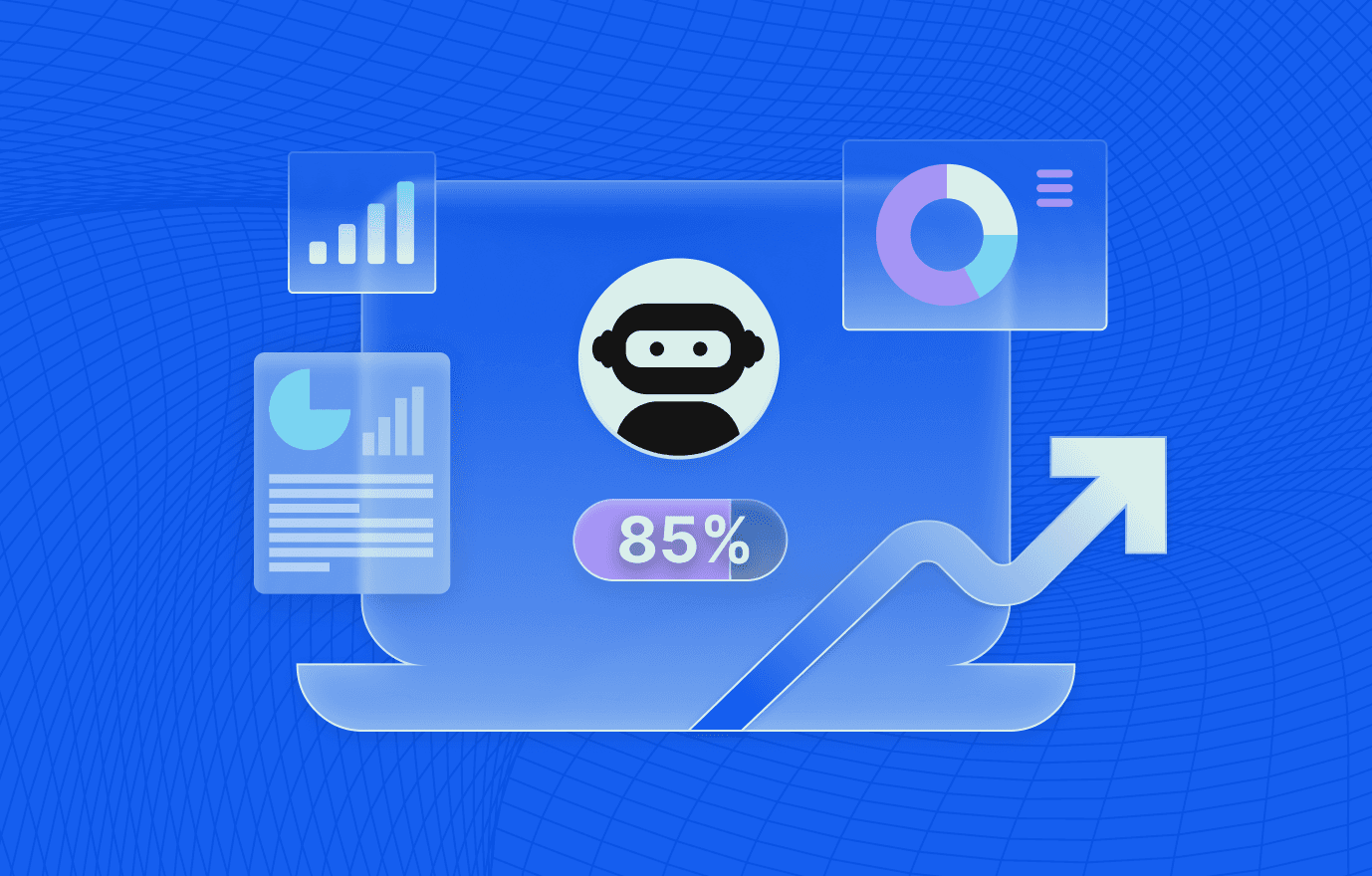Chatbot /
5 Min read
Top 27 Chatbot Statistics You Must Be Aware of in 2025
December 16, 2022
Bhavyadeep Sinh Rathod
Content Editor, WotNot
Chatbots are the future. Several businesses have embraced this AI-based technology. Small bots being an integral part of the website or mobile app is common. It is not just solely to take away the heavy lifting from your support team, but also from other crucial departments that help increase acquisitions and retention. Chatbots are known to improve conversions and materialize your ROI goals.
In this article, we will cover:
Key chatbot statistics
Industry-wise chatbot statistics
The main aim is to help understand the scope of chatbots in future and how they can prove to be useful for businesses and users.
Key Chatbot Statistics to Know
1. At least 40% of people claim to use chatbots for interactions regularly
Chatbots are gaining popularity and have been designed to improve response time. The growing need for convenience and instant gratification has led users to embrace this mode of communication. It assures instant replies and immediate resolution to issues (MarketingDive).
2. Chatbots have helped 55% of businesses improve their lead generation capabilities
This one of the crucial chatbot statistics since it involves a major business challenge — lead generation. Generally, businesses lose out on conversions as they are not able to track every visitor that enters the website or application. With a chatbot, you can collect the essential information and connect with them later. This will also help you with nurturing the lead and eventually converting them.
3. In 2021, 88% of the customers globally had at least one conversation with chatbots (Tidio)

Tidio conducted a survey that helped them realize that at least 96% of the surveyed customers are aware of chatbots. Out of them, at least 88% have used it to have conversations.
4. Chatbots are one of the fastest-growing communication channels for most brands (Drift)
This is one of the chatbot statistics that still holds as most businesses are still in the adoption stage. 9 in 10 respondents use conversational marketing to improve their interactions.
Chatbot Engagement Statistics
The usage and engagement have come a long way since the inception of the AI-powered bots. Here we will discuss some top chatbot statistics that give us an insight into how they perform.
5. 68% love engaging with chatbots because of the excellent response time. (Userlike)
The bots are known to interact almost immediately. There is zero wait time, and you get most of the queries solved because of their learning and past interactions. This results in enhanced experiences that boost the willingness of the end users to communicate with the brands via bots.
6. Chatbots are used to resolve complaints faster or to get quick answers in case of emergencies, according to a survey conducted by Drift
7. There are more B2B companies (58%) than B2C companies (42%) that have embraced chatbots for support and service

8. 46% of the companies have reported an increase in productivity as they have used bots for voice-to-text dictation
A lot of voice material that needs to be translated into text occurs via bots. The above chatbot statistics show that companies have started using bots as virtual assistants that manage the entire day.
Conversion Rates With Chatbots
Several businesses have noticed an increase in their conversion and retention rate with bots. When the user gets an answer as soon as they ask the question, they are more likely to complete the purchase. Here are some chatbot statistics that indicate the increased conversions with bots.
9. At least 41.3% of customers used chatbots to complete their purchases (Drift)
Customers are more than willing to complete their purchases with the help of a chatbot. The percentage of users who use chatbots for their purchases has gone up from 17.1% in 2019 to 41.3% in 2020. It is estimated that this trend will continue in 2025 too.
10. Many eCommerce stores have seen that a combination of Facebook messenger and chatbot for abandoned carts can improve their revenue by up to 25% (Chatbots Magazine).
Chatbots can improve your abandoned cart rates and enhance your conversion rates. It will pull back your customers.
Chatbots for Healthcare
Chatbots have been used in several ways in the healthcare segment. Let’s look at some of the major chatbot statistics that show how chatbots are used in this sector.
11. The market size was valued at $194.85 million in 2021. It is estimated to reach $943.64 million by 2030 (verified market research).

The adoption of smart devices, increased internet connectivity, and the need for virtual assistants to boost healthcare is the reason for the rising adoption.
Here are a few use cases for chatbots in healthcare to improve interactions.
a. Increased Patient Engagement
The chatbots connect with the patients to give them more accurate information that can help with care delivery.
b. Appointment Scheduling
You won't need to connect with a healthcare provider to book an appointment, thus saving you time. It will save the healthcare provider resources and costs.
c. Answer Quick Queries
Customer support can help with queries such as when the doctor will be available and other queries with greater speed.
12. At least 70% of healthcare industry users prefer talking to chatbots. They also prefer using it to offer their feedback.
13. Microsoft created the healthcare bot which responded to at least $1 million queries during the Pandemic.
Chatbots in Recruitment
14. 75% of the HR queries occur through HR chatbots
15. 62% of employees use chatbots to support their HR requirements
16. With HR chatbots, employees don’t need to wait for three or more days to get a response from the HR team
17. 92% of the HR departments direct new employees to the chatbots to attain information
18. Career sites use chatbots to engage with job seekers to get 95% more leads
Chatbots in Finance
19. In 2021, at least 16% of credit and mid-sized organizations intended to invest in chatbots. It was just 4% at the start of 2020 (Forbes).
20. Only 12% of the banks showcased readiness to adopt chatbots in 2021
21. The chatbot in BFSI was valued at $586 million in 2019. It is estimated to reach $6.83 billion by 2030 (Statista).

22. 87% of the customers reported a positive or neutral response to banking chatbots
23. Banks can save 826 million hours with chatbot interactions. With a chatbot, you can save up to 4 minutes per query.
Chatbots in Retail
24. Retail customers are impatient. At least 55% of the customers give up before the 10-minute mark, and 17% don’t wait even 5 minutes.
25. The chatbots have a 34% acceptance rate in the case of websites and mobile applications
26. At least $112 billion eCommerce transactions were completed through chatbots
27. 35% of the businesses in retail use chatbots as voice assistants
Conclusion
Most industries are showcasing chatbot readiness, which means there will be more businesses embracing bots in 2025. The power of automation combined with instant gratification can lead to better lead generation, customer support, and marketing capabilities for businesses.
It can cut operational and resource costs by several notches for the retail and healthcare sectors. With greater learning patterns, observant bots, and immersive algorithms, businesses can create more personalized chat flows to keep users engaged and retained in the business.
ABOUT AUTHOR
Bhavyadeep Sinh Rathod
Content Editor, WotNot
He likes technology, chatbots, comedy, philosophy, and sports. He often cracks hilarious jokes and lightens everyone's mood in the team.




